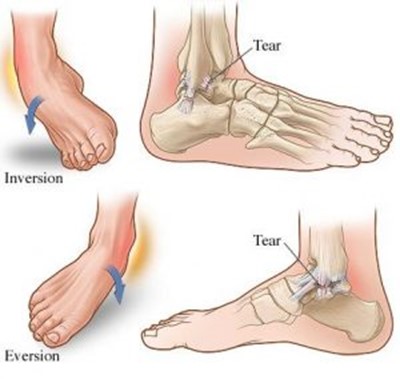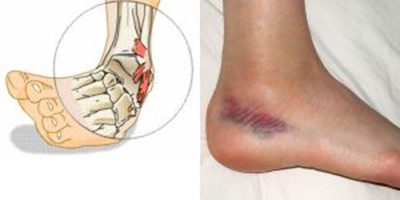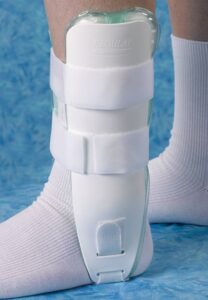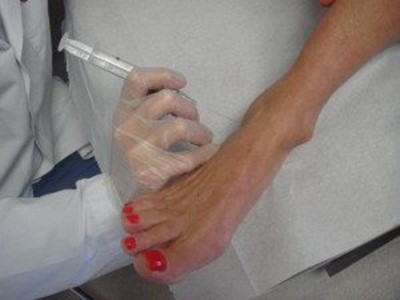
NEWS > The 10 questions you would like to ask about ankle sprain
The 10 questions you would like to ask about ankle sprain
Posted by Raffaello Riccio in Achilleo, dancers, Foot Surgery, minimally invasive surgery, dance, ankle sprain, foot pain, ankle instability, prolotherapy, High heels, Uncategorized18 Mar2018
How does a sprained ankle occur?
An ankle sprain occurs as a result of a sudden lateral movement and / or twisting of the foot. A sprained ankle can occur during sporting events or during mundane daily activities. A false step or an uneven ground surface is enough to cause a sprained ankle; this is why sprained ankles are among the most common orthopedic injuries. A sprained ankle usually occurs when a person lands by jumping or running on an uneven surface. For example, it often occurs when basketball players land from a jump by landing on another player’s foot. But a sprained ankle can also occur in routine daily activities, such as stepping off a sidewalk or stepping into a hole.
What happens inside the ankle when you have a sprain?
An ankle sprain is an injury to one or more ligaments in the ankle. Ligaments are bundles of fibers that control excessive movement of the joint. When an ankle sprain occurs, the ligament stretches too much, resulting in a partial or complete rupture.
There are two broad categories of ankle sprain:

Ankle Sprains in Inversion
The most common type of ankle sprain occurs when the foot goes into inversion, that is, it “turns” inwards. About 90% of ankle sprains are inversion injuries. When this type of sprain occurs, the lateral or external ligaments of the ankle undergo excessive distension, with possible partial or complete rupture. We have three main ligaments on the outer side of the ankle (peroneo-talus ant., Peroneo-calcaneal, peroneo-talus post). The pain is always on the outside of the ankle, and there is usually no pain on the inside.
Ankle Sprains in Eversion
The other type of ankle sprain is called eversion trauma, as the foot “turns” outward. When this occurs, the internal ligament of the ankle, called the deltoid ligament, stretches too much. Patients in this case will have pain on the inside of the ankle.
What are the symptoms of a sprained ankle?
The most common symptoms associated with an ankle sprain are pain with swelling and suffusion of blood (collection of blood beneath the skin’s surface). The severity of the symptoms is closely related to the extent of the damage of the ligament.
• Grade I Distortion:
Grade I is where ligament strain occurs without rupture. Symptoms tend to be limited to pain and swelling. Most patients can walk without crutches, but may not be able to run or jump.
• Grade II distortion:
A Grade II ankle sprain is more severe and consists of a partial tear of the ligament. There is usually more significant swelling and blood suffusion caused by a small hemorrhage under the skin. Patients usually have pain when walking, but it is possible to take a few steps.
• Grade III Distortion:
Grade III ankle sprains are characterized by complete injury to the ligaments. The ankle is usually very sore, and walking can be difficult. Patients may complain about instability, or a sagging sensation on the ankle.

As mentioned before, pain and swelling are the most common symptoms of a sprained ankle. Patients often notice bruising on the area of the lesion. These bruises will move down towards the foot and toes in the days following the sprain; the reason for this is the force of gravity that brings down the blood that has leaked into the tissues following the trauma.
When should I see a doctor after a sprained ankle?
You should see a doctor if you have any of the following symptoms as a result of a sprained ankle:
• Inability to walk on the ankle
• Noticeable swelling
• Symptoms that do not improve rapidly or persist even after the first few days
• Severe pain in the foot or above the ankle
Differentiating between a sprain and fracture of the ankle can be difficult and sometimes an x-ray may be necessary. While moderate pain and swelling are common symptoms following a simple ankle sprain, symptoms, such as inability to put weight on the leg, numbness in the toes, or pain that is difficult to manage, should arise a concern. If you think you’ve had more than just a sprained ankle, you should see a doctor.
What is the treatment for a sprained ankle?
Treatment of acute ankle sprain is important because returning to normal activities as quickly as possible is critical for most patients.
Early treatment of an ankle sprain is the so-called traditional Anglo-Saxon “RICE” method. However, if you are unsure of the severity of the sprain, consult a doctor before starting any treatment.

The following is an explanation of the RICE method for treating acute ankle sprains:
• Rest:
The first 24-48 hours after the injury is considered a critical period for treatment and activities must be limited. Gradually increase the load on the ankle as it is tolerated; abandon the use of the crutch when it is possible to walk normally with minimal or no pain.
• Ice:
For the first 48 hours after the injury, keep the ankle high by applying ice for 20 minutes at a time every 3-4 hours. The ice pack can be a bag of frozen vegetables (peas or corn), allowing it to be reused.
DO NOT apply ice to the ankle for more than 20 minutes at a time! It won’t help you heal faster, and it can cause tissue damage (burns)! Also do not continue to apply ice after 48 hours from the trauma; the ice keeps the blood away from the ankle, and also the blood cells needed to start the healing process !!
• Compression:
Use compression when lifting the leg in early treatment of the sprain. Using an elastic band, wrap the ankle from the toes up to the top of the calf, overlapping the elastic band half its width. The bandage should be snug, but not impede the blood circulation of the foot and ankle. So, if the foot becomes cold, blue, or falls asleep, remove the bandage and repeat the operation, tightening a little less!
• Elevation:
Keep your ankle higher than your heart as often as possible. At night, you can put something (eg books) under the foot of the bed.
For more severe ankle injuries, with complete ligament rupture and bone fractures, treatment other than a simple sprain may be required. It is important that you see your doctor before starting treatment or if your symptoms do not improve quickly in the first days after the trauma.
Many patients report a sprained ankle, see their orthopedist, have no evidence of fractures, but despite this the symptoms of the sprain seem to persist. If you have suffered a sprained ankle, and the symptoms don’t tend to go away, some simple exercises can help you improve.
• It is important that, before starting any rehabilitation program, a certain diagnosis is made. Patients who have persistent symptoms after a sprained ankle should be evaluated by their doctor to ensure that they do not have more serious damage, such as a fracture or a high ankle sprain, which could be causing these problems.
How to recover from a sprained ankle:
Limit the Immobilization
Prolonged immobilization can cause significant problems after an ankle sprain. Patients feel better if they are immobilized in plaster or in a brace, but this can lead to ankle stiffness, a delay in rehabilitation, and a predisposition to new episodes of sprain, if the immobilization is prolonged too long.

Damaged ankle ligaments will form fibrous scar tissue as they heal. This scar tissue will be tighter and less organized when patients have their ankle completely immobilized. Ligaments heal with appropriate length and better quality scar repair tissue when ankle motion is started early. In cases where the ligaments form a too thick scar reaction, normal movements can become painful, and the ankle can experience recurrence of the sprain.
Although walking without a brace is painful, patients should remove it several times a day to work on mobility exercises. These simple exercises can help the ligaments heal properly.
Range of motion exercises:
A few simple exercises can help maintain ankle motion, and stretch the ankle ligaments affected by the sprain.
• Stretching of the Achilles tendon
Achilles tendon stretch can easily be started right after you have sprained your ankle. While sitting or lying down, take a towel with both hands and wrap it around your toes. Pull the ends of the towel, pulling your toes upwards, and you will feel the stretch in the back of the ankle. Perform 3-4 times a day for several minutes.
• Writing the Alphabet
Sitting or lying down, write the letters of the alphabet in the air with your toes. Draw the letters as large as possible. Be creative looking for all uppercase letters, then lowercase letters, then italics, etc.
Strength Exercises
The next step in recovering from ankle sprains is to strengthen the muscles surrounding the ankle joint. By strengthening these muscles, you help support the ankle joint and prevent further injury.
Some exercises to do after an ankle sprain:
• Stand your toes
Standing on a step or ledge with your heel over the edge, stand on your toes, then in a controlled manner, let your heel drop down. Repeat 10-20 times (for each foot), 4 times a day.
• Walk on your toes and heels
Walk on your toes for one minute, then on your heels for another minute. Walk alternating heels and toes for a total of 10 minutes, repeating the exercise 4 times a day.

Proprioceptive gymnastics
Proprioception is our body’s ability to transmit feedback (Return Information) to our brain. After an ankle sprain, the proprioception of the joint can be damaged, causing problems in controlling the movements of the ankle.
The best way to recover and train proprioceptivity is to practice on an unstable swinging board.
Training for specific physical activities
These may include simply walking or jogging, or they may be more intense for athletes playing basketball, soccer, or other sports. The key, no matter if we are talking about an amateur or competitive level athlete, is to progress slowly. Start with a very low intensity, and with a short duration of activity, and progress gradually, avoiding suddenly increasing both the intensity and the duration of your sporting activity. It is essential that the activity is performed without pain.
What if the pain persists?
The most common cause of persistent pain following an ankle sprain is incomplete and insufficient rehabilitation. This means that patients either do not complete the correct type of rehabilitation, or they do not progress properly (i.e. too fast or too slow). If you find that progress is not going the way you expect, a consultation with your orthopedist is necessary.
Surgery is only very rarely a part of the treatment of an acute ankle sprain. Rather, patients who need surgery usually have chronic recurrent sprains, and persistent ankle pain. These patients have ligaments that have been completely injured and have not healed well, leaving the ankle unstable.
What conservative therapy can be considered for ankle sprains that do not heal quickly or evolve into ankle instability? The role of Orthopedic Regenerative Medicine …

The conservative treatment that I generally use in these cases, and which has proved very effective in strengthening and regenerating damaged ligament fibers, is Prolotherapy, a micro-infiltrative technique that belongs to the family of Orthopedic Regenerative Medicine, and which uses small local glucose injections with the aim of stimulating ligament regeneration of the affected ligaments. It is an infiltrative technique that consists in injecting, through small and thin needles, a solution of glucose in correspondence with the damaged ligament structures. These injections are able to stimulate a reaction of the ligamentous tissue that leads, over a few weeks, to the regeneration and thickening of the affected ligaments, which in this way return to effectively play their role of support.
What surgery is performed to treat chronic ankle sprains?
Patients who have chronic and recurrent ankle sprains usually have elongated and inefficient ligaments that therefore need to be re-tensioned or reconstructed.
The most commonly performed surgery to repair these ligaments is the retensioning of the ligament (or ligaments) broken or detended (also by means of a minimally invasive technique), according to Brostrom.
In this surgery, the ligaments on the outside of the ankle are re-tensioned, and the thick tissue around these ligaments, called the retinaculum, is advanced. This procedure restores loose tissue tension, restoring stability to the ankle.
How do I know if my ankle is unstable?
Ankle instability can be detected both by a careful clinical examination and by special diagnostic investigations. First of all, in the ankle instability, the patient reports recurrent episodes of sprain, even for trivial movements of everyday life.
• Clinical examination
In the physical examination, the doctor can stimulate the affected ligaments and assess whether they have healed satisfactorily. By comparing the opposite ankle, the doctor can get an idea of how loose the sprained ankle is compared to the normal ankle.
• Radiographic tests
An x-ray examination may be performed to assess the stability of the ankle. By straining the ligaments, and simultaneously taking an X-ray, the doctor can check the stability of the ankle.
What other problems could be causing chronic ankle pain?
There are a number of causes of chronic ankle pain, and it is important to make sure you have a certain and accurate diagnosis before embarking on a treatment program.
Causes of chronic pain following ankle sprains can be:
• Incomplete rehabilitation
• Injury to other ligaments
• Subtalar ligament injuries
• Injuries to the ligaments of syndesmosis
• Cartilage injuries (OCD)
• Nerve damage
• Reflex sympathetic dystrophy (Algodystrophy)
• Dysfunction of the peroneal tendón
This is not a complete list, but it only lists some of the potential causes of chronic ankle pain.
Therefore, if you suffer from persistent pain after an ankle sprain, a careful orthopedic evaluation is necessary for a correct diagnosis. Only then is it possible to start a treatment focused on your specific problem.
